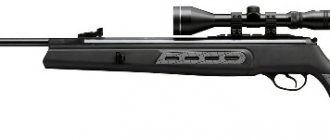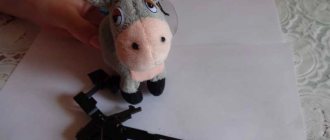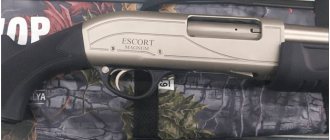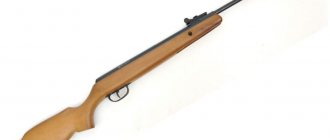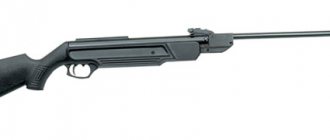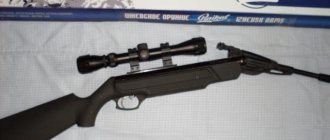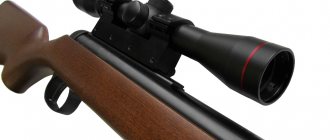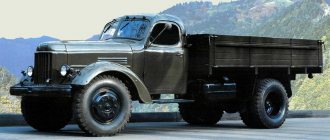The Hatsan 125 air rifle is the most popular spring-piston air rifle in our country. The high popularity of the Hatsan 125 rifle is explained by its high power, firing range, solid appearance and ease of shooting from it. The rifle can be used for training and recreational target shooting. The Hatsan 125 rifle is produced at a Turkish factory in Izmir. The Hatsan 125 rifle has one of the best price-quality ratios on the market.
Technical characteristics of Hatsan 125
- Caliber:
4.5 mm (.117) - Barrel type:
rifled - Number of grooves:
10 - Rifling direction:
right-handed - Operating principle:
spring-piston pneumatics - Cocking principle:
barrel fracture - Charge capacity:
single charge - Initial bullet speed:
380 m/s - Power:
7.5 J - Barrel length:
500 mm - Total length:
1205 mm - Weight:
3.65 kg
Design
The Hatsan 125 air rifle is a spring-piston, single-shot air rifle.
The Hatsan 125 rifle is equipped with a 500 mm long steel rifled barrel with 10 right-hand rifling. The rifle barrel caliber is most often 4.5 mm, although the manufacturer produces rifles in other calibers. Due to the length of the barrel, the balance of the rifle is shifted towards the barrel, which can be corrected by the rifle owner by weighting the stock. A plastic muzzle is installed at the end of the barrel, which makes cocking the rifle easier.
The energy source of the Hatsan 125 rifle is a mechanical spring. The rifle comes with two springs: one less powerful one is installed on the rifle so that the power of the rifle is within 7.5 Joules, the second more powerful one is included in the kit. Most owners of the Hatsan 125 rifle immediately after purchase install a more powerful spring, which provides an initial bullet speed of 380 m/s. Mechanical springs of air rifles have one serious drawback: they shrink quickly, so some owners replace them with gas springs. Inside the gas spring there is gas, which is compressed by the piston. Gas springs have a long service life, but are very sensitive to negative temperatures. It is not recommended to shoot at temperatures below -10 degrees; gas spring seals may fail.
The Hatsan 125 rifle is equipped with a Quattro Trigger trigger mechanism, which is a unique development of Hatsan and has been installed on their air rifles for more than 30 years.
The Hatsan 125 rifle is equipped with an automatic safety; when cocking the rifle, it automatically switches to a safe mode in which firing a shot is impossible. The red icon indicates that the rifle is in the firing position and is ready to fire.
The butt of the Hatsan 125 rifle is made of high-strength, high-hardness plastic. The color of the butt can be several options: dark, wood and camouflage. Sometimes you can find Hatsan 125 rifles from early years of production and limited editions whose buttstock is made of Turkish walnut. The length of the stock is adjusted using removable elastic pads of the TRIOPAD system. Additional inserts and a shock-absorbing butt pad significantly reduce recoil and make shooting more comfortable.
The Hatsan 125 rifle is equipped with open sights: a front sight made of fiber-optic thread with a diameter of 1.5 mm and a rear sight with fiber-optic threads in the form of a TruGlo bar. Using micrometric screws, the position of the aiming bar is adjusted horizontally and vertically. Fiber-optic threads are painted in contrasting colors. The rear sight is green, the front sight is red. Contrasting colors of the sight allow you to shoot in low light conditions.
The receiver of the rifle has milled grooves for installing an optical sight. When choosing an optical sight for the Hatsan 125 rifle, you should keep in mind that it, like many other spring-piston air rifles, has strong recoil. Hatsan tried to reduce the recoil of the rifle with a vibration compensation system (SAS), as well as through the pads and butt plate.
It is better to choose an optical sight with a constant magnification, designed for installation on spring-piston rifles, capable of withstanding their strong recoil. The optical sight should only be installed on a monoblock bracket that must have a stopper.
Review of Hatsan 125TH. Speed and accuracy
We continue our review of the Hatsan 125TH air rifle; in this article we will measure speed and accuracy.
Hatsan 125TH speed test
During the speed test, a couple of things became clear:
First, in production the rifle is lubricated exactly as much as necessary. If at the very beginning, during cocking, extraneous sounds were heard and friction was felt, then after 30 shots everything got used to it and stabilized. Second, a big rifle has a lot of speed. The very first shots reached a speed of 360 m/s, which, in fact, is expected from a rifle of such power.
Beeman Kodiaks bullet test
Beeman Kodiaks, weighing 0.69 g, showed approximately 311 m/s at 125TN. The spread is from 308 to 317 m/s. The overall spread in speed is 9 m/s - I think we can say that this is an established value. On average, a bullet produces 33 J of muzzle energy, which is not bad for a .177 caliber.
Test with Crosman Premier
The next ones in my test are 0.51 g. spherical Crosman Premier. For a rifle of this power they are considered light, and that's not all. Adding antimony to lead takes its toll at these speeds. These bullets showed an average velocity of 361 m/s, with a range from 355 to 262 m/s. On average, their muzzle energy was 33 J. The spread is less than that of the Kodiaks.
Test with RWS Hobby
Hatsan claims 380 m/s with lead bullets, and the RWS Hobbys are the most suitable lead bullets for this rifle. Of course, in principle, any half-gram RWS bullets will show similar results. The fact is that the Hobbys sat most tightly in the 125TN barrel, so their velocity spread was the smallest of all three types of ammunition. The spread is only 6 m/s. The average speed is 382 m/s, fluctuations are from 380 to 385 m/s. The average muzzle energy was 33 J.
Impressions from the Hatsan 125TH speed test
In general, the impressions are only positive. The Quattro trigger could use a little less pull without compromising safety, but the SAS shock absorption system works at full strength. Their stated speeds coincided with real ones when using lead bullets. This, to be honest, is a surprise, albeit a pleasant one.
Hatsan 125TH accuracy test
Let's try the rifle in action using only open sights. We'll install the optics a little later to get the most complete picture of the 125TN - its accuracy and ease of use.
The 125TN has an open rear sight with a TruGlo fiber optic insert. In general, a fiber-optic sighting device is not a very good choice if you need ultra-precise shooting - it blocks too large a field of view; but on a bright sunny day it is very clearly visible. They are appropriate at distances up to 25 meters, but are absolutely not suitable for distances above average or hunting in the forest.
The size of the rear mark on the 125TN is very small compared to the front scope of the sight - this creates inconvenience when aiming. I also discovered that the barrel has a rather strong downward slope: from a distance of 25 meters the bullet hits below the target even with the rear sight raised to the maximum. Naturally, this has a bad effect on accuracy at long distances. I think installing an optic will only solve this problem if I can compensate for barrel tilt with a finer adjustment.
Beeman Kodiak bullet test
The first thing I tried during the accuracy test was the Beeman Kodiak. My choice fell on them, because... they do not exceed the sound barrier, which is important when shooting indoors. The distance was 25 meters, I took a 10-meter pistol target. The first group of hits turned out to be the best of the entire day, although at first glance it did not look successful. But she told a lot.
Ten Beeman Kodiaks with a spread of 3.2 cm at 25 meters. Note that the hits are stretched vertically, not horizontally, this is important.
The hits turned out with a spread of 3.2 cm, but this is in length. It is only 2.4 cm wide. This result remained stable all the time.
Bullets that don't fit
I tried using 0.54 g. hemispherical JSB Exact, which can break the sound barrier, but the spread of hits with them was very large. Hemispherical AirArms of the same weight also performed poorly.
But the worst bullets are the H&N Rabbit Magnum II. To begin with, their body walls are smooth, so they do not fit into the breech of a rifle with a breakable barrel - you simply cannot push them in there with your finger, you need some kind of tool. But this is not news to me. The first shot went about 25 cm higher than any other bullet in this test, and it seemed to me that I had found a miracle bullet for this rifle! But no, the second bullet missed the target by 30 cm, after which I immediately stopped experimenting with these bullets.
Heavy Crosman Premier
I remember that 0.68 gr. The heavy Crosman Premiers can perform very well, so I gave them a chance. The total spread was 5.4 cm, but vertically all the bullets fit into a gap of 3.4 cm. Again it was repeated that the hits were extended in length and not in width. Well, I decided to try these bullets again, with an optical sight.
Wrong grip?
I tried different grips while shooting the Kodiak, the most accurate bullet in this test. This time the spread was 3.4 cm, but the width was only 2.8 cm. Again, more vertically than horizontally.
This group of hits were made with Kodiak bullets, but with a different artillery grip. Again, the group turns out narrower, but longer.
So, the grip didn't really change anything, but it is now clear that you can't achieve much with open sights. I'm lacking vertical accuracy, which I'm going to fix by simply mounting the optics.
Rifle feel
The trigger cannot be pulled upward or anywhere else to the side - the thumb hole in the butt directs the pressing force clearly back. Plus the hook is too heavy to be comfortable. At the second stage of its stroke, although there is no excess play of the hook, the length of the stroke itself is still significant.
The SAS shock absorption system works great. When firing, you can feel some vibration, which goes away very quickly - the system is working.
The recoil of the rifle is strong. But again, it is perfectly extinguished and does not interfere with shooting. The best grip on a rifle is when your left hand touches the front end of the trigger guard.
It would be much more enjoyable to shoot the rifle if the trigger were lighter, but I'm gradually getting used to the cocking force and can't wait to install an optic.
Having attached two-component brackets to the optical sight, but then they had to be unscrewed and moved again, because... They didn't fit exactly where they were on the guide. All this took just a couple of minutes, and Hatsan includes a special key in its rifle. No difficulties. The sight is moved a little back, because had to adjust the offset of the aiming point so that it coincided with the position of the pupil. All the screws that secure the scope are strong and strong enough to support its weight, so there are no problems with that either.
Hatsan 125 modifications
The Hatsan company produces the Hatsan 125 rifle in several modifications:
- Hatsan 125
rifle a standard modification that has a black stock made of impact-resistant plastic, a universal combo rail for installing an 11 mm dovetail + Weaver / Picatinny 22 mm optical sight. - Hatsan 125E
rifle a modification of the rifle, with a black plastic butt and a bar for mounting a dovetail optical sight. - The Hatsan 125 TH rifle
is a modification of the rifle that has a stock with a pistol grip with a cutout in the butt for winding the finger. The power of the Hatsan 125 TH rifle is 32 Joules. Rifle length 1205 mm. Rifle weight 4.1 kg. - The Hatsan 125 Vortex rifle
is a modification of the rifle equipped with a refillable Vortex gas spring. At the factory, the spring is inflated to a minimum, but with the help of a filling fitting, the spring power can be increased, bringing the bullet's flight speed to 380 m/s. - The Hatsan 125 TH Vortex rifle
is a modification of the rifle, equipped with a refillable Vortex gas spring and a butt with a pistol grip with a cutout for the winding of the finger. - The Hatsan 125 Sniper rifle
is a modification of the rifle that has a built-in sound moderator (silencer) designed to reduce shot noise. The rifle buttstock has an adjustable cheekpiece and the package includes a plastic bipod. The Hatsan 125 Sniper rifle has a length of 1240 mm and weighs 4.1 kg. - The Hatsan 125 MW rifle is
a modification of the rifle with a stock made of Magic Wood walnut. - The Hatsan 125 TH MW rifle is
a modification of the rifle with a stock made of Magic Wood walnut with a pistol grip formed by a hole for the thumb. - The Hatsan 125 Camo rifle
is a modification of the rifle equipped with a camouflage-colored plastic stock. - The Hatsan 125 TH Camo rifle
is a modification of the rifle, equipped with a camouflage-colored plastic stock with a pistol grip in the form of a thumb hole.
Choosing a universal powerful air rifle
I thought about buying an air rifle for three reasons. First: the crows were annoying me at the dacha, because of which I was losing my harvest. Second: I wanted to purchase a weapon to hone my shooting skills. Third: just shoot at different targets.
Photo by Mikhail Fetisov
So, I decided to buy an air rifle.
Now many will say, take PSP.
But then I thought differently.
I had a choice of PP pneumatics.
CO2 - not suitable for birds and long range shooting.
And for me, power always came first, followed by accuracy and rate of fire.
Having sadly assessed my financial capabilities, I chose three companies for myself: Crosman, Hatsan, Gamo. I thought for a long time... And I chose Hatsan.
Gamo didn’t inspire confidence, and Crosman didn’t take it because of the nitro piston (it’s too whimsical).
As a result, I began to choose rifles from the Hatsan company. I had a difficult choice between the 150 and the 125. I chose 125 as it is more common.
And soon I became the owner of a PP air rifle model Hatsan 125 TN in 4.5 mm caliber (since Hatsan simply does not have a larger caliber).
At first glance, the rifle looks like a rifle, but the deeper you dive into it, the more interesting it becomes. I'll describe her appearance a little. The length of the rifle is 125 cm. The butt and fore-end are made of impact-resistant black plastic.
The rifle has a pistol grip, which is convenient for shooting while lying down, sitting and standing. The front sight is made of fiberglass, which allows you to shoot at dusk.
Now I’ll tell you about its penetrating ability (I inserted a reinforced spring). From 50 m - 25 mm of pine board right through. From 35 m - 40 mm of the same board right through. From the last distance, only the first wall of the motor oil drum.
All this was done by firing “Shmel YaRS” 0.88 g bullets. From 15 meters, metal 1.5 mm thick can only be penetrated by a Gamo Rocet 0.60 g bullet. I would like to note that the Hatsan 125 only needs heavy bullets, from 0. 88 to 1 g. However, I got carried away with the power.
Now about accuracy. The accuracy was disappointing - you can actually shoot without optics only up to 35 m. Further - only with well-aimed optics. But note that if you select the bullets well, then at 50 m the pile is no more than 5 cm.
Advantages
The Hatsan 125 rifle has become one of the most popular air rifles due to its advantages:
- High shot power
- a rifle with a mechanical spring is capable of delivering 29-32 Joules, a rifle with a gas spring is capable of delivering 32-36 Joules. - High initial bullet speed
- the rifle's bullet speed reaches 380 meters per second, which exceeds the speed of a bullet fired from a Makarov pistol (315 m/s). - Good accuracy of the rifle
- a rifle with a coil spring at a distance of 25 meters in a series of 5 shots provides a dispersion diameter of 3 mm, at a distance of 50 meters the dispersion diameter increases to 5 mm. - Good appearance of the rifle
- the rifle looks like a real weapon and not like a child's toy. - The ability to adjust the rifle to the shooter’s parameters
due to elastic inserts, and in the Sniper modification also due to the adjustable cheek piece. - Possibility of modernization
- by installing an optical sight and replacing the spring with a spring of higher power. - Optimal price-quality ratio.
Review of bullet manufacturers
There are about 10 large companies in the global arms market that produce bullets for air guns. However, after studying reviews from owners of the Hatsan-125 rifle with a gas spring, as well as the opinions of experts, we came to the conclusion that only three companies produce cartridges that are most suitable for the model under review. Here is a block with a rating, as well as the cost of 4.5 mm cartridges:
| Place | Name | Rating | Price and number of cartridges |
| 1 | "Luman" Classic | 9.5/10 | 265 rubles (300 pcs) |
| 2 | Crosman Premier | 8.9/10 | 590 rubles (500 pcs) |
| 3 | Baracuda Match | 8.7/10 | 690 rubles (400 pcs) |
The most popular among Russian hunters are the Luman Classic bullets, produced in Lugansk. Why this particular ammunition? It's all about low cost, as well as versatility. This cartridge is equally well suited for training shooting and for hunting at short and long distances. It also produces more specialized ammunition, so the range will please anyone - from a hunter to a lover of sports shooting and exotics.
Many experts agree that for the Hatsan-125 gas spring rifle, it is best to use Crosman Premier heavy ammunition, designed for magnum class rifles. However, due to the fact that these bullets are not sold in every gun store, and also because of their high cost, not everyone buys American cartridges.
However, this cartridge fits well under the Hatsan rifled barrel and also has impressive technical characteristics.
Well, in third place are the German Baracuda Match cartridges from the H&N company, which are considered the best ballistic projectile for training and target shooting all over the world. This ammunition has an increased mass (0.69 grams) as well as an increased diameter (4.51 millimeters), which has an excellent effect on accuracy. However, not every rifle is capable of firing such a cartridge without damaging the barrel. Fortunately, this does not apply to Hatsan-125, which is capable of withstanding much greater loads.
Flaws
With all the advantages that the rifle has, it also has some disadvantages:
- Heavy Recoil - The rifle's large compressor and spring-piston operating principle result in fairly strong recoil, which often results in a strong and painful blow to the finger, as well as a "sniper injury", that is, a broken eyebrow of the rifle owner.
- The need for a high-quality optical sight that can withstand the strong recoil of a rifle. A rigid monoblock should be used to mount the sight; the optical sight must be able to withstand strong recoil.
- Heavy weight of the rifle - due to its heavy weight, the rifle is not well suited for recreational shooting for children and women.
- Breaking the barrel to cock and load a rifle requires a lot of physical effort.
- The mechanical coil spring shrinks after several hundred shots, so many rifle owners replace it with a gas spring.
- The large size of the rifle and the balance on the barrel reduce the maneuverability and usability of the rifle.
Tuning and upgrading the rifle
To improve the quality of shooting, many owners of the Khatsan 125 rifle are upgrading it. In most cases, rifle tuning comes down to two main changes:
- Replacing a standard mechanical coil spring with a higher capacity spring? Or a gas spring.
- Installing the optical sight on the mount provided for it on the rifle.
Purpose
The Hatsan-125 aerial vehicle is intended for training and entertainment purposes and targeted shooting at targets. With this device you can hone your skills in just a few months. Hunting with the Hatsan 125 rifle is also considered quite common. The 4.5 mm caliber allows shooting at small game: wild ducks, hares, quail, squirrels and other small animals. The optimal distance for shooting is 50-70 meters. With proper skill, when hunting with the Hatsan-125, you can hit a target even from a distance of a hundred yards (91 meters), and when installing an optical sight, hunting takes on real excitement, because the distance for a shot increases to 200-300 meters.
Increasing rifle power by replacing the spring
Many rifle owners either immediately after purchase or after some time increase the power of the rifle by replacing the spring with a more powerful mechanical coil spring or gas spring.
The mechanical coil spring of the Hatsan 125 rifle begins to shrink after several hundred shots, and after 1000-1200 shots it becomes completely sluggish, the power of the rifle decreases, and the initial speed of the bullet decreases to 250 or even 200 meters per second. The best way to increase the power of a rifle is to install a gas spring.
A gas spring uses energy from gas compression. When the barrel breaks, the piston compresses the gas in the cylinder. During the shot, the gas in the cylinder presses on the piston, creating the energy of the shot. Installing a gas spring on a rifle increases the range of the shot, increases the speed of the bullet, reduces recoil and simplifies the process of cocking the rifle. Installing a gas spring on a rifle is not very difficult; it can be done either in a store that sells pneumatics or at home. Many owners of Hatsan 125 rifles, when replacing a mechanical spring with a gas one, not only change the spring itself, but also chamfer the muzzle of the barrel, change the cuff and o-rings, and polish the piston and cylinder.
Repair and replacement of parts
The main parts that require replacement over time are springs and optics. Hatsans, due to their power, give a very solid recoil, and after two hundred shots the optics, even good ones, go astray. It should be replaced. See photo.
Repair and replacement of parts
The power of the rifle allows you to hit, for example, a bird at a distance of up to 150 meters, but there is no need to talk about accuracy. An accurate and strong shot is limited to a maximum of 50 m.
Experienced shooters advise installing a gas piston instead of the iron spring that comes with the standard kit. The piston provides greater accuracy and targeted power to the weapon.
In addition, the so-called “sniper injury”, namely a broken eyebrow from the recoil of the sight, can most often be found among all pneumatics on the Hatsan 125 model.
Selection and installation of an optical sight
Most owners of the Hatsan 125 rifle install an optical sight on it. According to experienced pneumatic enthusiasts, a 4x32 optical sight for the Hatsan 125 rifle will be quite sufficient. The Hatsan 125 rifle has great power and strong recoil, so you only need to purchase a high-quality scope that can withstand such recoil. The optical sight should be installed on a monoblock bracket.
Which optics should you choose?
Since this rifle has high power and firing range, an optical sight will be a must-have purchase to get the most out of your weapon. Suitable for 4x and 8x models. When choosing, be sure to pay attention to the mounting method, as it must be compatible with the 11mm strip. Also, do not buy too cheap models, as the recoil of the weapon is quite high and because of this, the settings will constantly be lost, and in the worst case, the lens may crack.
For example, you can pay attention to Gamo 4x28, and if this magnification is not enough for you, you can take a closer look at Gamo 3-9x32. This is high-quality and relatively inexpensive optics, which comes standard with the mount we need. It handles recoil perfectly and will last a very long time.
Photo of the Gamo 4×28 optical sight
Depreservation
After purchasing a rifle from a store, the owner of the rifle should re-open it. Most Hatsan 125 rifles are thickly coated with a special preservative grease, which must be removed before shooting. This can be done both in a weapons workshop and at home.
Preservative weapon grease should be removed from the outer surfaces of the rifle, and the grease should also be cleaned from the inner surface of the barrel. To clean the barrel, you should use a special airgun cleaning kit, which includes a plastic-braided cleaning rod. A steel cleaning rod should not be used to clean the barrel; it can flare the rifling on the breech side of the barrel, or flare the rifling on the muzzle side. All this will lead to a deterioration in the speed of the bullet and will worsen the accuracy of the rifle.
After this, you need to unscrew the stock fastenings and separate the barrel with the receiver and remove excess lubricant from all surfaces. The cylinder, trigger and cocking mechanism should not be disassembled unless necessary. If after a series of 10-20 shots you hear the rifle growling when firing and feel sticky grease when loading the rifle, you will have to disassemble the cylinder with the piston. The rifle is disassembled, the piston is removed, the piston and compressor are wiped with a dry cloth and a thin layer of gun oil or silicone grease is applied to them. The rifle is assembled and zeroed.
Shooting
Before firing a rifle, it must be properly sighted. It is best to zero in an air rifle indoors; if you do not have the opportunity to visit the shooting range, wait for clear and calm weather, since the flight of the bullet is influenced by environmental factors: temperature and humidity, precipitation, gusts of wind.
For zeroing, it is best to use a special zeroing machine, but if you don’t have one, you can use a vice, a flat horizontal surface, a bipod, or sandbags to fix the rifle.
For zeroing, use a regular sports round target with a black center. It is best to start zeroing the open sight of the Hatsan 125 rifle at a distance of 10 meters, gradually increasing the distance to 25-30 meters. The sighting of the optical sight mounted on the Hatsan 125 rifle begins immediately at a distance of 23-30 meters, then increasing to 40-45 meters.
Spring-piston rifles tend to reduce the power of the spring when firing in series, so you should pause between shots for 1-2 minutes, and after every five shots you need to take breaks of 15 minutes. Reload the rifle very carefully so as not to move the rifle. When zeroing the open sight of a Hatsan 125 rifle, it is recommended to use Diablo bullets weighing 0.68 grams; when zeroing an optical sight, you should increase the weight of the bullets to 1.02 grams.
The rifle is zeroed in series of 5 shots, the midpoint of impact is determined and the sight is adjusted. The sight is first sighted in the vertical plane, then in the horizontal. The rifle is zeroed until the difference between the aiming point and the impact point becomes minimal.
Disassembly
Partial disassembly of the Hatsan 125 rifle is carried out for maintenance, lubrication and maintenance and repair work. To disassemble the rifle, perform the following steps:
- Unscrew the screws securing the stock to the rifle and separate the stock
- Unscrew the screw of the fuse axis
- Unscrew the screw of the trigger mechanism axis
- Disconnect the fuse spring
- Remove the sear axle
- Remove the backplate pin
- Remove the piston and spring
The rifle is assembled in the reverse order.
